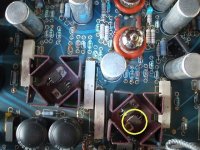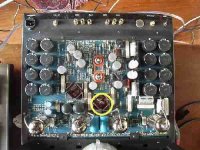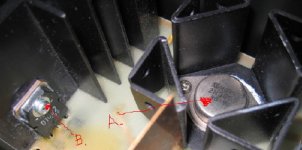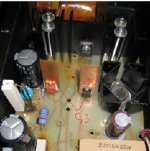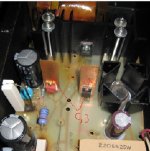Hello
I own a melos triode 200+ stereo who had burned a transistor, probably because some old capacitors who altered the values, that now we replaced with some new ones. Unfortunately the data on the transistor are unreadables. We tried to replace the old transistor with other similar values, but with bad results (the sinusoid results cutted in low).
Please, somebody have the originals or can read the data on the originals to try to find them? Or can tell us the address of somebody who can know it?
We obviously can pay for spare parts and correct informations.
Thankyou very much in advance.
my email is zigozigo3@hotmail.com
The transistor is the one in the yellow circle.
I own a melos triode 200+ stereo who had burned a transistor, probably because some old capacitors who altered the values, that now we replaced with some new ones. Unfortunately the data on the transistor are unreadables. We tried to replace the old transistor with other similar values, but with bad results (the sinusoid results cutted in low).
Please, somebody have the originals or can read the data on the originals to try to find them? Or can tell us the address of somebody who can know it?
We obviously can pay for spare parts and correct informations.
Thankyou very much in advance.
my email is zigozigo3@hotmail.com
The transistor is the one in the yellow circle.
Attachments
This may not be much help but my memory says that Melos used screen grid drive on this amplifier. So you may be needing a mos-fet in that position. (4 tubes=4 fets)
Victor
Victor
Thankyou for your reply HollowState.
Now there are 2 hypothesis:
- it is a mosfet, ok but what mosfet? There are thousands of mosfets.
- it is a regulator LM317 or LM337.
Tomorrow we will try to understand something more with instruments.
Now there are 2 hypothesis:
- it is a mosfet, ok but what mosfet? There are thousands of mosfets.
- it is a regulator LM317 or LM337.
Tomorrow we will try to understand something more with instruments.
HollowState said:This may not be much help but my memory says that Melos used screen grid drive on this amplifier. So you may be needing a mos-fet in that position. (4 tubes=4 fets)
Victor
Seems that it's a mosfet, like you told Victor. But what mosfet?
And now seems that there could be a problem to one of the output transformer.
PLEASE, SOMEBODY HAVE A MELOS TRIODE 200+ STEREO OUTPUT TRANSFORMER?
it is the plus version, then the toroidal.
This is only a guess. I would try a general high voltage N-channel mosfet. Perhaps something like an IRF820 (500v-40watt) or an IRF830 (500v-75watt) These units are cheap and easily available. And they are the correct mounting type (TO220 or Y220b)
These are not the only choices by any means. And remember, it's only my best guess.
Also, check the condition of any clamping diodes used around the source-gate junction (if any).
Victor
These are not the only choices by any means. And remember, it's only my best guess.
Also, check the condition of any clamping diodes used around the source-gate junction (if any).
Victor
zigo3 said:Thankyou Victor.
I try them by sure and I will tell you the result.
I found that on another Melos triode 200 are mounted 2 identical transistors who are marked "ST D01111 - MOROCCO - P3NB100 - FP".
An externally hosted image should be here but it was not working when we last tested it.
I don't know if they are originals, all the powamp have some original parts substituted and only 2 of the 4 driver transistors was readables.I did searched them with google but I did'nt find them. Please somebody can help?
Thankyou very much in advance.
Rob
zigo3 said:
I found that on another Melos triode 200 are mounted 2 identical transistors who are marked "ST D01111 - MOROCCO - P3NB100 - FP".An externally hosted image should be here but it was not working when we last tested it.I don't know if they are originals, all the powamp have some original parts substituted and only 2 of the 4 driver transistors was readables.
I did searched them with google but I did'nt find them. Please somebody can help?
Thankyou very much in advance.
Rob
A friend from this thread http://www.audiokarma.org/forums/showthread.php?t=145708 found them.
In the power supply module of my Melos GK-1 there was a transistor mounted in a similar heat sink. If you think it is worthwhile pulling the cover and so on, I'll look and see what it is. I believe that I replaced it when I rebuilt the PS.
Another thing — Melos under-engineered the heat management in my pre-amp. Could it be true of your amp as well? I vastly increased the size of some heat sinks in accordance with some advice I received from a professional. Perhaps heat was the cause of your transistor failure in the first place. The transistor in question was finally mounted vertically on a massive, finned aluminum sink.
Another thing — Melos under-engineered the heat management in my pre-amp. Could it be true of your amp as well? I vastly increased the size of some heat sinks in accordance with some advice I received from a professional. Perhaps heat was the cause of your transistor failure in the first place. The transistor in question was finally mounted vertically on a massive, finned aluminum sink.
Lorne said:In the power supply module of my Melos GK-1 there was a transistor mounted in a similar heat sink. If you think it is worthwhile pulling the cover and so on, I'll look and see what it is. I believe that I replaced it when I rebuilt the PS.
hello Lorne
if it's not a disturb for you, everything is well accepted and know what is mounted on your pre could be interesting. Even if i suppose your transistors could be similar to those of Sha Gold, low current transistors.
Lorne said:Another thing — Melos under-engineered the heat management in my pre-amp. Could it be true of your amp as well? I vastly increased the size of some heat sinks in accordance with some advice I received from a professional. Perhaps heat was the cause of your transistor failure in the first place. The transistor in question was finally mounted vertically on a massive, finned aluminum sink.
Thankyou so much, this is a very good suggestion. I will follow it by sure.
Please, what heatsink size did you mount on yours? Did you substituted all the original heatsinks?
Thanks in advance
Hi Zigo3: Sure thing! Give me a bit of time. It is a bit more involved than the stock hood. I put a whole new cover on the power supply module (it's separate on the GK-1). On top of the hood, there is a large 12 VDC computer fan.
I have drawings and notes to remind me what heat sinks were replaced and so on. I have no idea as to how similar or not this unit is to yours. But, there are two transformers. And this power supply gets hot. In the summer, it gets very hot. The transformers give off a lot of heat. When I rebuilt the module, the big cement resistors had scorched the board. Some parts showed signs of bad heat stress. One transistor in a sink like yours had discolored the board in the immediate area. There was nothing wrong with the unit. As far as I know, it was performing as designed. But I rebuilt the module to save the amp from disaster in the future.
To tell you the truth, I am going to rebuild it again using (a) point to point wiring (b) a bigger chassis (c) a fully ventilated cage. It's the only pre-amp I know of that will help heat a room in winter!
I replaced most of the parts — including the transistors and regulators. Some small glass encased diodes I was not able to identify. I had to put them back in the circuit.
I hope that my English is not too difficult for you. I can easily understand yours🙂
I'll be back with news — Lorne
I have drawings and notes to remind me what heat sinks were replaced and so on. I have no idea as to how similar or not this unit is to yours. But, there are two transformers. And this power supply gets hot. In the summer, it gets very hot. The transformers give off a lot of heat. When I rebuilt the module, the big cement resistors had scorched the board. Some parts showed signs of bad heat stress. One transistor in a sink like yours had discolored the board in the immediate area. There was nothing wrong with the unit. As far as I know, it was performing as designed. But I rebuilt the module to save the amp from disaster in the future.
To tell you the truth, I am going to rebuild it again using (a) point to point wiring (b) a bigger chassis (c) a fully ventilated cage. It's the only pre-amp I know of that will help heat a room in winter!
I replaced most of the parts — including the transistors and regulators. Some small glass encased diodes I was not able to identify. I had to put them back in the circuit.
I hope that my English is not too difficult for you. I can easily understand yours🙂
I'll be back with news — Lorne
Hi Zigo,
Look at the first attachment. The device of interest is 'A'. I believe that I replaced this. It is the same as the stock/original. Written on it is 'Mospec 2N3055 XO 96'. I thought that I had enlarged the heat sink. But when I look at my notes, I see that I didn't.
Now look at 'B'. The original was a TO package like 'A'. The replacement is an SC-65 package — a D1092.
The original heatsink for 'B' was about the same area/volume as 'A'.
Now go to the next attachment (in the next post after this one) and compare the replacement heatsink with the one used by 'A'. There is a massive difference.
My reference manual says that both of these devices (A & B) are used in television circuits. It is interesting because some or all of the tubes used in the GK-1 are also types that were commonly used in television.
Now, find 'C'. 'C' indicates devices used in a regulation section. Originally these were free standing and had no sink wafer. I fixed a single copper fin to them.
I had not looked at the board for some time. I can see that the diodes I replaced have stayed in good condition — no sign of charring or stress. But, I made a mistake. I put the large cement R's too close to the surface of the board. You can see where the board has been burned. And worse — two large capacitors seem to have been boiled. And this happened even after a large fan was put on top of the hood. I am going to have to completely rebuild and change this PS circuit before I use the pre-amp again.
I do not have any idea if this helps you with your Melos model. I hope it does. It is a shame that no documents exist for Melos gear — Lorne
Look at the first attachment. The device of interest is 'A'. I believe that I replaced this. It is the same as the stock/original. Written on it is 'Mospec 2N3055 XO 96'. I thought that I had enlarged the heat sink. But when I look at my notes, I see that I didn't.
Now look at 'B'. The original was a TO package like 'A'. The replacement is an SC-65 package — a D1092.
The original heatsink for 'B' was about the same area/volume as 'A'.
Now go to the next attachment (in the next post after this one) and compare the replacement heatsink with the one used by 'A'. There is a massive difference.
My reference manual says that both of these devices (A & B) are used in television circuits. It is interesting because some or all of the tubes used in the GK-1 are also types that were commonly used in television.
Now, find 'C'. 'C' indicates devices used in a regulation section. Originally these were free standing and had no sink wafer. I fixed a single copper fin to them.
I had not looked at the board for some time. I can see that the diodes I replaced have stayed in good condition — no sign of charring or stress. But, I made a mistake. I put the large cement R's too close to the surface of the board. You can see where the board has been burned. And worse — two large capacitors seem to have been boiled. And this happened even after a large fan was put on top of the hood. I am going to have to completely rebuild and change this PS circuit before I use the pre-amp again.
I do not have any idea if this helps you with your Melos model. I hope it does. It is a shame that no documents exist for Melos gear — Lorne
Attachments
Lorne said:Hi Zigo3: Sure thing! Give me a bit of time. It is a bit more involved than the stock hood. I put a whole new cover on the power supply module (it's separate on the GK-1). On top of the hood, there is a large 12 VDC computer fan.
I have drawings and notes to remind me what heat sinks were replaced and so on. I have no idea as to how similar or not this unit is to yours. But, there are two transformers. And this power supply gets hot. In the summer, it gets very hot. The transformers give off a lot of heat. When I rebuilt the module, the big cement resistors had scorched the board. Some parts showed signs of bad heat stress. One transistor in a sink like yours had discolored the board in the immediate area. There was nothing wrong with the unit. As far as I know, it was performing as designed. But I rebuilt the module to save the amp from disaster in the future.
To tell you the truth, I am going to rebuild it again using (a) point to point wiring (b) a bigger chassis (c) a fully ventilated cage. It's the only pre-amp I know of that will help heat a room in winter!
I replaced most of the parts — including the transistors and regulators. Some small glass encased diodes I was not able to identify. I had to put them back in the circuit.
I hope that my English is not too difficult for you. I can easily understand yours🙂
I'll be back with news — Lorne
Hello Lorne
you are absolutely right, my Melos powamp suffered a lot because heat too: there are pcb areas who are brown, instead of green, because heat. In particular around those big white resistors that I suppose are similar to yours.
About schematics I found only a preamp service manual: if this can help you tell me I will send you by email.
Lorne said:Hi Zigo,
Look at the first attachment. The device of interest is 'A'. I believe that I replaced this. It is the same as the stock/original. Written on it is 'Mospec 2N3055 XO 96'. I thought that I had enlarged the heat sink. But when I look at my notes, I see that I didn't.
Now look at 'B'. The original was a TO package like 'A'. The replacement is an SC-65 package — a D1092.
The original heatsink for 'B' was about the same area/volume as 'A'.
Now go to the next attachment (in the next post after this one) and compare the replacement heatsink with the one used by 'A'. There is a massive difference.
My reference manual says that both of these devices (A & B) are used in television circuits. It is interesting because some or all of the tubes used in the GK-1 are also types that were commonly used in television.
Now, find 'C'. 'C' indicates devices used in a regulation section. Originally these were free standing and had no sink wafer. I fixed a single copper fin to them.
I had not looked at the board for some time. I can see that the diodes I replaced have stayed in good condition — no sign of charring or stress. But, I made a mistake. I put the large cement R's too close to the surface of the board. You can see where the board has been burned. And worse — two large capacitors seem to have been boiled. And this happened even after a large fan was put on top of the hood. I am going to have to completely rebuild and change this PS circuit before I use the pre-amp again.
I do not have any idea if this helps you with your Melos model. I hope it does. It is a shame that no documents exist for Melos gear — Lorne
Thankyou so much Lorne! Your suggestions are very interesting, in particular about those television transistors. On my 200+ are mounted some television tubes too.
Those A and B transistors are high or low current?
And your heatsink ideas are very interesting too. great idea to mount a computer fan too. I think I will follow your "street" to try to cool better mine too, once it will perform without problems (I hope 🙂 ).
All these Melos products, if are right, perform very well, but it's unbelievable that they was mounted in a so fragile way and that there was only ONE place, in USA, where the schematics was disposables to repair them correctly. I can understand that business is business and restauration is a part of business, but there are limits...
At the end a good after-buy service produce more business: next time I will try a power amp firstly I will see how many time they are protected by the guarantee, then if the schematics are availables.
Your english is perfect for me 🙂
Thanks again
zigo
p.s.
great drivers you have in your avatar, I have a pair of HPD315 mounted on Devon cabinets.
PM sent to you Zigo. Thanks.
None of following is reliable information. It is only what I have scraped off the net as reported by members of the audio community over the last eight years or so. I cannot verify as to it's unalloyed accuracy.
As for the Melos documents — schematics and so on: as far as I know, the entire archives of the Melos company were sold at auctioned ‚ or were intended to be sold. This happened after Melos declared bankruptcy. The appointed receivers had possession of the archive. Unless I have gone crazy, I actually remember seeing the notice. I believe that I even asked myself if for a couple of thousand dollars I should try to buy the stuff myself. I've asked around. No one knows who — if anyone — got the documents. No one that I have heard from, anyway. And no one knows where the documents are. Well ... perhaps someone does, but not anyone that you and I know, for sure.
And furthermore, the word went around that the service company that set itself up to repair and restore Melos products was doing so from memory. That is, they were relying on staff who had worked at Melos to remember stuff.
In my opinion, there is more Melos stuff out there than meets the eye. A lot of it must have failed and faded by now. And it makes sense that if you own the documents for an orphaned family of products, you would keep them secure. You would capitalize on their unique importance. They would put a service company in a unique position. So the mystery gets more intense, because no one to my knowledge is using the archive — if in fact it still exists.
None of following is reliable information. It is only what I have scraped off the net as reported by members of the audio community over the last eight years or so. I cannot verify as to it's unalloyed accuracy.
As for the Melos documents — schematics and so on: as far as I know, the entire archives of the Melos company were sold at auctioned ‚ or were intended to be sold. This happened after Melos declared bankruptcy. The appointed receivers had possession of the archive. Unless I have gone crazy, I actually remember seeing the notice. I believe that I even asked myself if for a couple of thousand dollars I should try to buy the stuff myself. I've asked around. No one knows who — if anyone — got the documents. No one that I have heard from, anyway. And no one knows where the documents are. Well ... perhaps someone does, but not anyone that you and I know, for sure.
And furthermore, the word went around that the service company that set itself up to repair and restore Melos products was doing so from memory. That is, they were relying on staff who had worked at Melos to remember stuff.
In my opinion, there is more Melos stuff out there than meets the eye. A lot of it must have failed and faded by now. And it makes sense that if you own the documents for an orphaned family of products, you would keep them secure. You would capitalize on their unique importance. They would put a service company in a unique position. So the mystery gets more intense, because no one to my knowledge is using the archive — if in fact it still exists.
uhhh, long shot, old thread
anybody has a schematic for this amplifier (melos triode 200+ stereo) , I have problems with the waveforms of the input of the OPTubes, they are BTW on G2. I guess it's a defective mosfet, but they test OK with my elcheapo tester, need schematic ! the mosfets that are fitted are SSP4N70.
any help is deeply appreciated
anybody has a schematic for this amplifier (melos triode 200+ stereo) , I have problems with the waveforms of the input of the OPTubes, they are BTW on G2. I guess it's a defective mosfet, but they test OK with my elcheapo tester, need schematic ! the mosfets that are fitted are SSP4N70.
any help is deeply appreciated
- Home
- Amplifiers
- Tubes / Valves
- Melos triode 200+ looking for spare parts
